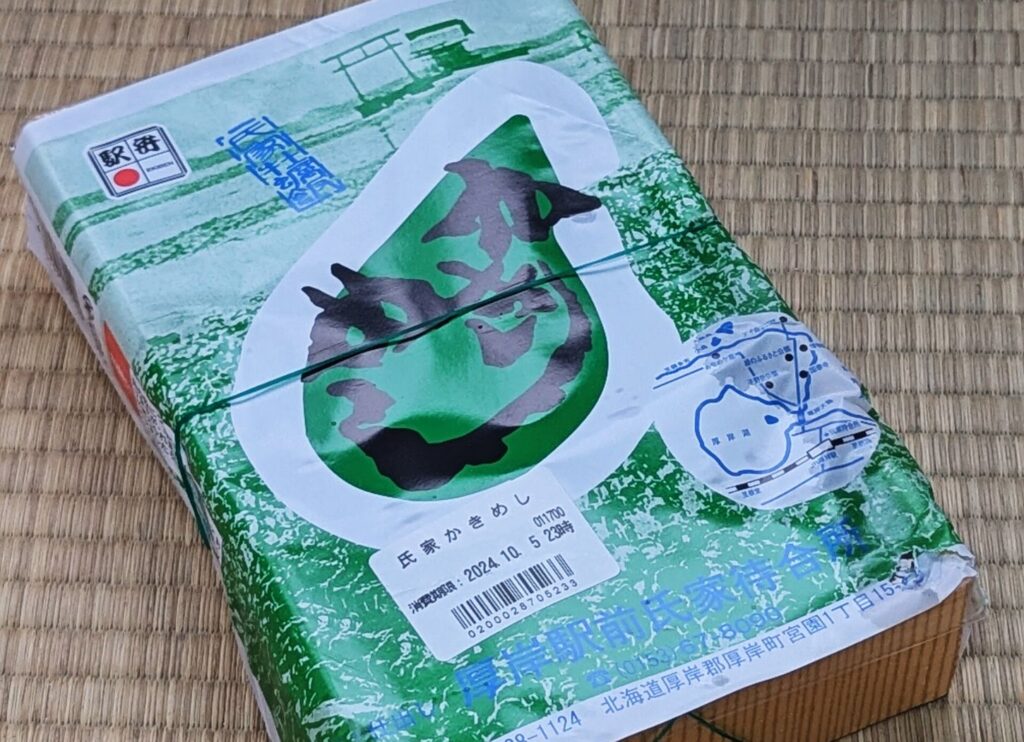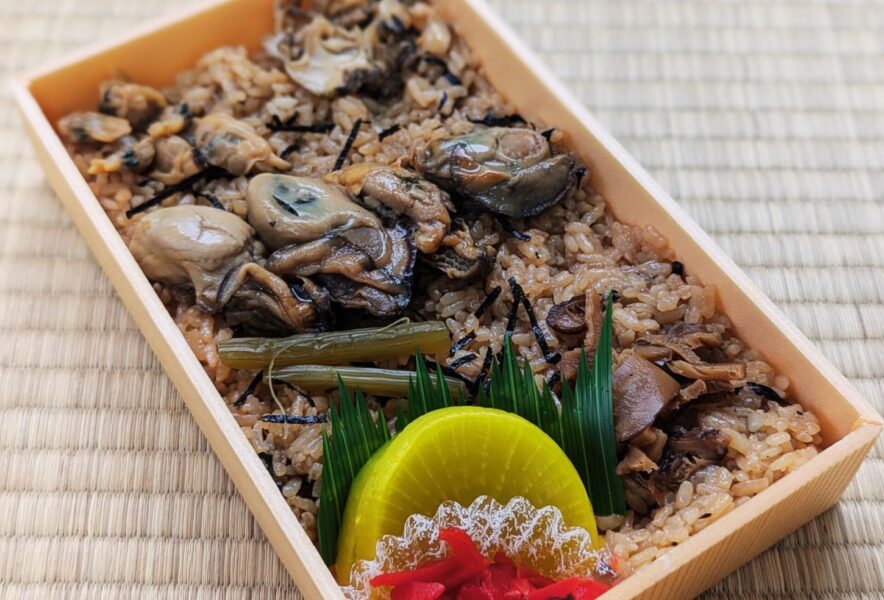Hokkaido is home to numerous culinary delights, and one of the most cherished and historically significant is the “Ujiie Kakimeshi,” a famous ekiben (station bento) from the coastal town of Akkeshi. Known for its rich seafood offerings, Akkeshi has long been synonymous with oysters, and the “Ujiie Kakimeshi” encapsulates the region’s deep connection to the sea.
If you’re a fan of seafood, traditional Japanese cuisine, or just ekiben culture, this exquisite bento is not to be missed. It’s a window into the bountiful offerings of the Pacific Ocean and Hokkaido’s natural resources, packed with over a century of history, tradition, and flavor.
In this blog, I’ll be diving into the story behind “Ujiie Kakimeshi,” breaking down its unique elements, and explaining why it has captivated food enthusiasts and travelers alike for over 100 years.

A Tradition Born in 1917: The Story Behind “Ujiie Kakimeshi”
The history of “Ujiie Kakimeshi” goes back to 1917, when it was first introduced by the Ujiie family, now a multi-generational operation still running strong. Akkeshi, a town famous for its oyster farming, needed a way to showcase its natural riches to the traveling public, and the idea of incorporating these prized oysters into an ekiben was a brilliant one.
The founder of Ujiie’s, Kosaburo Ujiie, was inspired by the simple, hearty meals of the local fishermen, who ate rice cooked with oysters as a daily staple. Kosaburo’s son, Yasuo Ujiie, decided to translate this dish into something that could be enjoyed by travelers passing through the town’s railway station. This decision marked the beginning of one of Japan’s most beloved ekiben.
Now, more than a century later, “Ujiie Kakimeshi” continues to win the hearts of locals and tourists alike. Its enduring appeal lies in the care taken to preserve traditional recipes while also catering to modern palates.
What Makes “Ujiie Kakimeshi” So Special?
1. The Rice – A Foundation of Flavor
The rice in “Ujiie Kakimeshi” is one of the most important components. It’s not just any ordinary rice but is carefully cooked using oyster broth, which infuses every grain with a delicate yet unmistakable seafood flavor. This method of cooking rice with dashi or broth is not uncommon in traditional Japanese cuisine, but in this ekiben, it’s elevated by the use of freshly harvested oysters.
In addition to the oyster broth, the rice is mixed with hijiki (a type of seaweed) and other subtle seasonings, providing a rich and complex base that perfectly complements the toppings. This simple yet flavorful foundation highlights the essence of Akkeshi’s coastal bounty.
2. The Toppings – A Feast for the Senses
The toppings of the “Ujiie Kakimeshi” are a celebration of both sea and land. Naturally, the star of the show is the oyster. Plump, juicy, and packed with umami, the oysters are slow-cooked to retain their tenderness. This careful cooking process ensures that the oysters are succulent without becoming rubbery – a common pitfall when cooking shellfish.
In addition to oysters, other seafood like whelk (tsubu) and clam (asari) join the mix, offering a variety of textures and flavors. These briny delights are paired with earthy mountain vegetables like fuki (butterbur) and shiitake mushrooms, creating a balance that appeals to both seafood lovers and those who appreciate the earthy tones of forest vegetables.
The visual presentation is also stunning – the various ingredients are neatly arranged on top of the rice, creating an enticing and colorful display that mirrors the beauty of the natural environment where these ingredients come from.
3. The Aroma – A Gateway to Akkeshi
One of the defining features of the “Ujiie Kakimeshi” experience is the aroma that greets you the moment you open the bento. The briny scent of the ocean mixed with the earthy tones of shiitake and the sweetness of the oyster broth create an olfactory experience that is almost as rewarding as the taste.
The aromas are a gateway to the culinary and natural landscape of Akkeshi, bringing a small part of Hokkaido’s coastal environment right to your hands, even if you’re far from the shore.
Where Can You Get “Ujiie Kakimeshi”?
While “Ujiie Kakimeshi” is a must-try in Hokkaido, you can also find it outside of the region. If you’re in Tokyo, there are several convenient places to pick up this special ekiben.
1. Akkeshi Station
The most authentic place to purchase “Ujiie Kakimeshi” is directly from Akkeshi Station. There’s something special about enjoying an ekiben that’s been made in the very place where the ingredients were harvested. Akkeshi is a stop on the JR Nemuro Line, and the station itself is modest but well-known among railway enthusiasts and foodies for being the home of this famous bento.
2. Ujiie Waiting Room
If you’re visiting Akkeshi, you can also pick up the bento at the “Ujiie Waiting Room,” located just in front of the station. Here, you’ll be able to order the bento directly from the source. They take pride in the freshness of their ingredients and the careful preparation of each bento, so you’ll be assured that the quality is top-notch.
3. Tokyo Station – Ekibenya Matsuri
For those in Tokyo, “Ujiie Kakimeshi” is available at Ekibenya Matsuri, located within the JR East Shinkansen area of Tokyo Station. This shop is a haven for ekiben lovers, offering a wide variety of bento boxes from all over Japan. If you’re planning to take the Shinkansen from Tokyo, I highly recommend picking up “Ujiie Kakimeshi” here before boarding. It’s a delicious companion for a long journey, and with the shop located right inside the Shinkansen ticket gates, it’s incredibly convenient.
Whether you’re heading to Kyoto or any other destination, grabbing a bento before you get on the train is an essential part of the experience!
The Growing Popularity of Ekiben Culture
While “Ujiie Kakimeshi” is a standout in its own right, it’s also part of the broader phenomenon of ekiben culture in Japan. Ekiben, or station bento, are more than just meals for train passengers; they’re carefully crafted culinary experiences that showcase regional ingredients and flavors. Travelers often seek out specific ekiben as part of their journey, turning a quick meal into a memorable and often highly anticipated part of their trip.
In recent years, ekiben culture has expanded far beyond the station, with specialty stores in major cities and events like ekiben fairs where you can sample a wide range of regional bento boxes.
A Taste of History
In the fast-paced world of modern travel, it’s easy to overlook the importance of a good meal. However, ekiben like “Ujiie Kakimeshi” remind us of the connection between place and food, and how tradition can be preserved in even the most convenient of formats.
Next time you find yourself in Hokkaido, or browsing through Ekibenya Matsuri at Tokyo Station, be sure to seek out this special bento. Whether you’re a lifelong oyster lover or someone who’s never had the chance to try these briny morsels, “Ujiie Kakimeshi” offers a unique, flavorful journey through Hokkaido’s coastal landscape.
With its blend of history, tradition, and impeccable ingredients, “Ujiie Kakimeshi” isn’t just a meal – it’s an edible piece of Akkeshi’s history. Enjoying this bento is a delightful way to connect with the heart of Hokkaido’s rich culinary traditions, whether from the seat of a train, at a station, or from the comfort of your home.

Comment